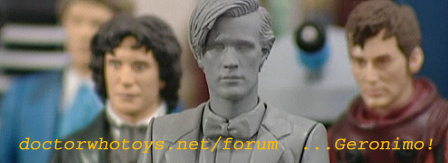doctorwhotoys.net







Exclusive Interview with Edmund Barnett-Ward, Director of Sculpting at Designworks Windsor, the company that sculpts Character Options
Doctor Who Action Figures
This interview took place in Windsor, England on the 27th February 2008 and is Strictly
Copyright © doctorwhotoys.net, All Rights Reserved; may not be reproduced in full or part.
All images are for the exclusive use of doctorwhotoys.net approved by and copyright © Designworks Windsor, Character Group plc and the BBC

Part 1 Behind the Scenes at Designworks
Part 2 All About Ed
Part 3 A Little History
Part 4 The Making of Doctor Who Action Figures
Part 5 Traditional Sculpting
Part 6 Sculpting Materials
Part 7 Approval
Part 8 Digital Sculpting
Part 9 The Sculptors
Part 10 The Story So Far
Welcome to Part 8 of a multi-part 10,000 word series describing in detail the making of Doctor Who Action Figures and including 63 exclusive new images of the figures in various stages of production.
"There are some figures produced using CAD that are yet to be released so I cannot talk about them," says Ed. "But the Cyberman is one figure that was sculpted digitally."
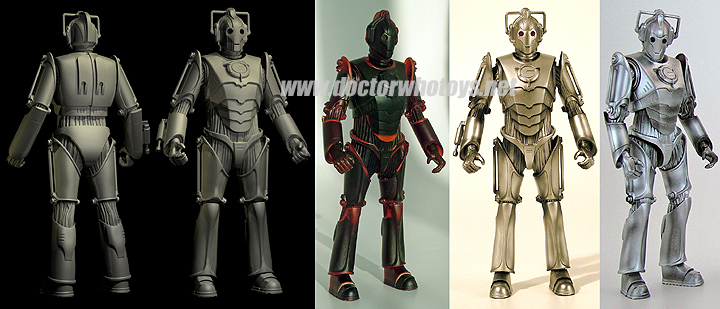
Cyberman 5" Digital Sculpt, Prototype and Approval Decos - All images exclusively approved for use only on doctorwhotoys.net by Designworks, Character Options and the BBC.
"The cyberman was created entirely on computer using the system, Freeform."
"Freeform is what they call scientifically a 'haptic' device - that's to say a device which gives feedback based on three dimensional data. So what you have is an arm, a stylus which you hold in your hand, that creates the impression that you are touching something physical that you see on the screen. So its a very good tool for a sculptor because essentially you get a virtual ball of clay that you can 'carve' into and physically feel. Its not the sort of computer aided design where you have to have a degree in computers to understand it."
"A sculptor can sit down in front of it and work away; thats the advantage. We have people here who specialize just in this. We have one guy who is an absolute genius with it, and probably after him I use it the most (when I sculpt). The first version of the cyberman was done by Alex, the second one which we did for the Collector's Centre was done by me and then I did the revision of it. We also did a magnetic toy for Character that was a kit composed of different bits that I did."
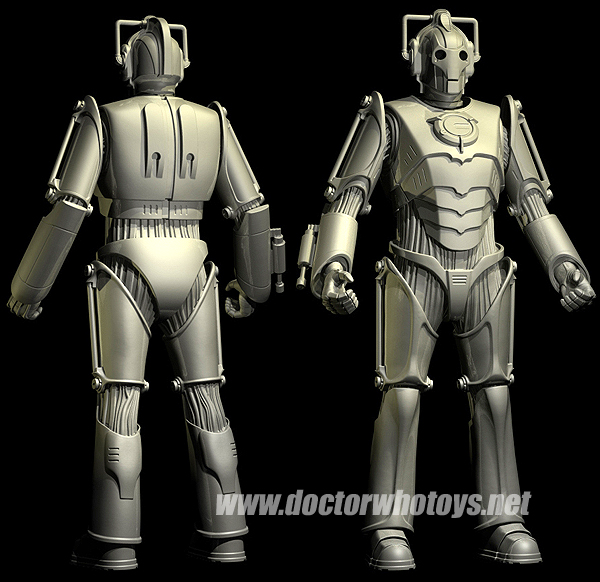
Cyberman Digital Sculpt - All images exclusively approved for use only on doctorwhotoys.net by Designworks, Character Options and the BBC.
"As objects come off the rapid prototyping machine there's a build structure that supports the item. The cyberman, for example, in its constituent parts came out of a printer that squirts resin which is UV cured. So there's a light behind the head and as its laying down a layer of resin the light behind it cures off that layer of resin. The prototype cyberman action figure was thus made of many many thousands of microscopic layers of material."
"The rapid prototype machine turns three dimensional data, fed in from the sculptors work on the Freeform program, into physical objects. There are many different types of these machines that create the object in different ways. The one that we use, as a machine of choice for things of this scale, is called Perfactory."
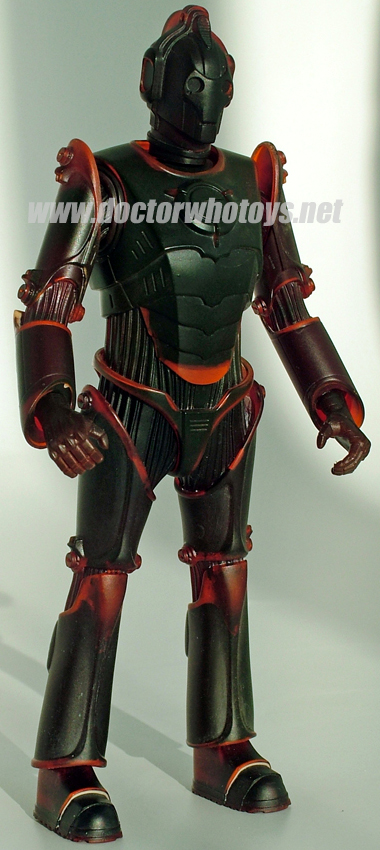
Prototype Cyberman - All images exclusively approved for use only on doctorwhotoys.net by Designworks, Character Options and the BBC.
"For the cyberman each component part was designed separately on screen in Freeform, the 3D data was then fed into the Perfactory rapid prototype machine, and 'printed' out. Each component emerges with a fine lattice work of support which is broken off and sanded to get the finished item. It's pretty much the same design technique as a traditional sculpt, but just done on screen. The main difference where it excels is that you only have to do one half of the sculpt; if you look at the cyberman he is basically symmetrical so obviously the left and the right leg for example are the same, just mirrored."
"The cyberman is by no means the only sculpt done on computer. We have done likenesses as well. Captain Jack's head, the most recent one, was done using Freeform."
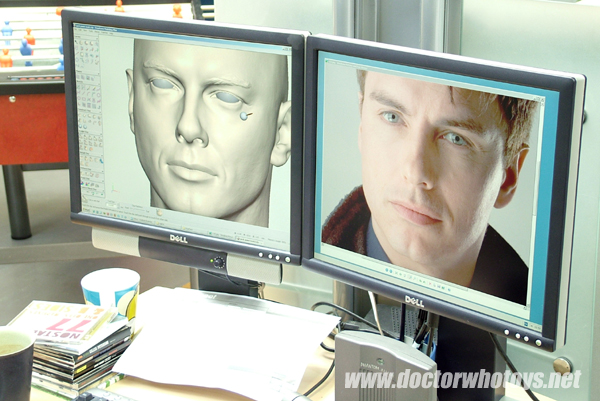
Captain Jack Harkness Digital Sculpt and Reference - All images exclusively approved for use only on doctorwhotoys.net by Designworks, Character Options and the BBC.
"At the moment, while the technology is as it is, I don't see more and more sculpting being done this way though. The economics of it don't stack up for every day use because what you have when you do something in Freeform is you have the time it takes the sculptor to sculpt it in Freeform, which is pretty much the same amount of time it takes them to make it physically, but then at the end of that process you have got a digital file which has to be outputted - it costs about half as much again to get it actually turned into a physical model and then finished to a level where its ready to be moulded. So it tends to be about a third to two thirds more expensive than having it sculpted via the traditional route."
"Hence we use Freeform almost exclusively for two sorts of projects:
- One, a project which would be extremely difficult to do technically by hand. For that you might think about something like the Future Predator from Primeval where we want to put articulation in it and we have it as a digital file so we can add the articulation into the model in the computer.
- Two, an object that you are going to use again in different scales. So the file that we created for the cyberman was used for both the 5" and the 12" - its exactly the same file; you only need to get it approved by the BBC once and as its accurate it will be the same in whatever scale you produce it in. Its also then straightforward to do versions like the Cyber Leader and Cyber Controller; we just have a 'swap out' part, its easy to do."
"The traditional sculpting technique and the new CAD techniques are as good as each other. But they are also only as good as the person using them."
"There's nothing magical about Freeform that you can just press a button and it will produce a figure. If the sculptor using it is not up to the task, it will not produce good results."
"Ironically, the sculptor who produced the Doctor Constantine sculpt is actually the same person who produced the cyberman using Freeform. That particular individual is unique - he is a genius, a brilliant, brilliant sculptor. He is capable of achieving an amazing level of detail with an incredible degree of accuracy. The guy that tends to do the David Tennant figures on the other hand doesn't really get on with Freeform, but he's an absolute genius when it comes to manipulating traditional materials."
"I've had people who've come from other backgrounds who do Freeform work and you can see in their portfolios that it's awful. It's the same when I see a sculptor who has awful work in their portfolio. If you don't have an eye for proportion and for scale and all those important things, Freeform doesn't sort any of those things out for you."
"In a way I'd like to think that in the future all sculpting would be done on computer, simply because commercial sculpting is quite a toxic environment."
"We use a lot of chemicals, and that's never good. If I could have it that everything we did was perfectly chemical free, better for the planet and better for the people doing the job. So if that meant everyone using computers that would be great. Perhaps in the toy industry things will go this way."
"Certainly today you have a lot more cross fertilisation of digital information. For example, some of the creatures that we produced for the Primeval action figures are taken directly from the digital information that was used to create the creatures in the programme. Framestore, the largest visual effects and computer animation studio in Europe, do all the digital effects for Primeval for Impossible Pictures and they will send me their file of the Future Predator and I can just output it as a figure; I mean it's more complex than that but essentially that is the process."
"There are companies in the world like Gentle Giant, based in Burbank California, who will go onto a film set and digitally scan the actor using a three dimensional scanner, and that information is taken and used for the special effects for the film. The same information is taken back by them and used to create the computer game version of that character and the same information is also used to create products like action figures."
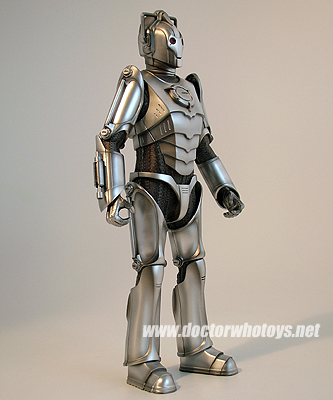
12" Cyberman Approval Deco - All images exclusively approved for use only on doctorwhotoys.net by Designworks, Character Options and the BBC.
Footnote: In April 2010 Ed was interviewed by ITN about the Matt Smith sculpt which was realised with the aid of a special new 3D hand-held digital scanner...
Thanks Ed
Now Read Part 9: The Sculptors
Don't miss Part 9 in which Ed talks exclusively to doctorwhotoys.net about the sculptors at Designworks. Also in Part 9 Ed explains exactly what is required to produce a good sculpt.
Part 1 Behind the Scenes at Designworks
Part 2 All About Ed
Part 3 A Little History
Part 4 The Making of Doctor Who Action Figures
Part 5 Traditional Sculpting
Part 6 Sculpting Materials
Part 7 Approval
Part 8 Digital Sculpting
Part 9 The Sculptors
Part 10 The Story So Far
This interview is Strictly Copyright © doctorwhotoys.net, All Rights Reserved; may not be reproduced in full or part. All images are for the exclusive use of doctorwhotoys.net approved by and copyright © Designworks Windsor, Character Group plc and the BBC
List 12" Gallery News Contact
Content is copyright © doctorwhotoys.net
